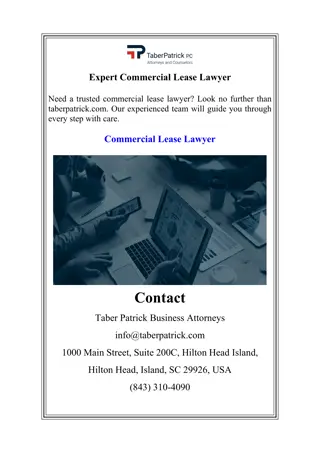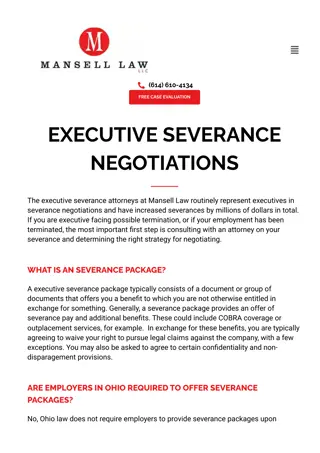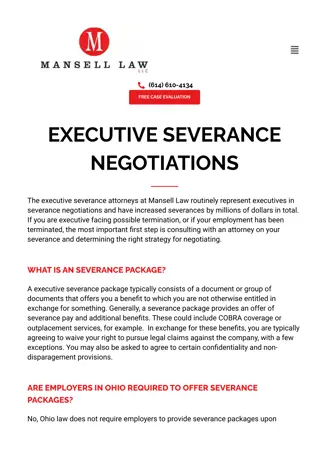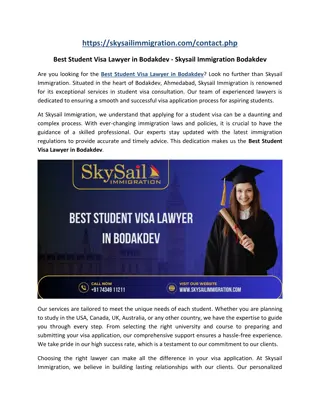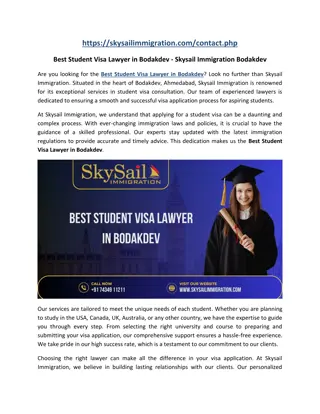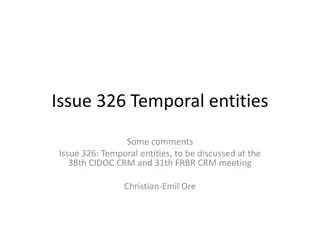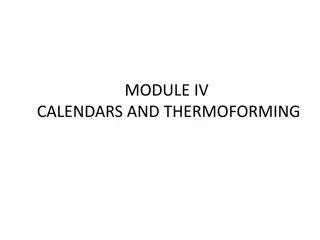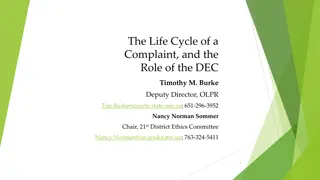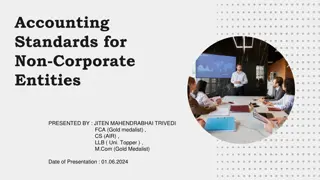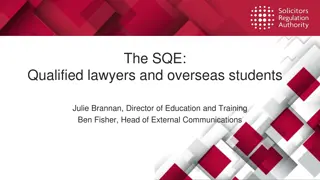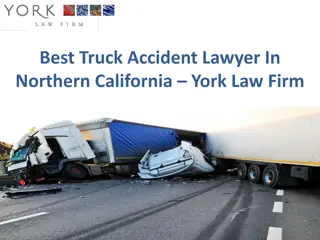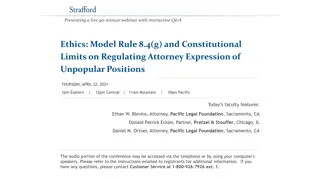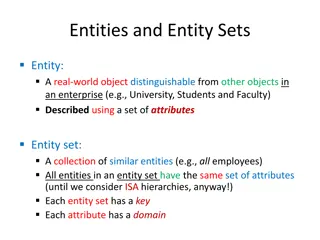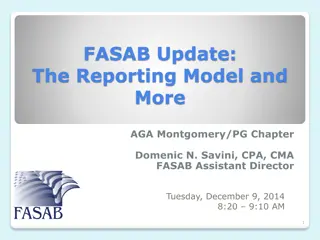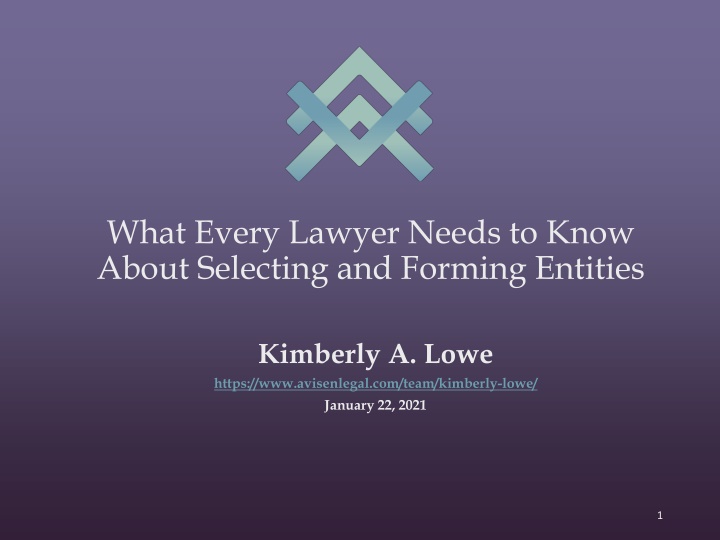
Comprehensive Guide on Selecting and Forming Business Entities for Lawyers
Learn essential considerations for lawyers when selecting and forming business entities, covering topics such as sources of law, determinants of liability, taxation choices, and entity options like sole proprietorship and general partnership.
Download Presentation

Please find below an Image/Link to download the presentation.
The content on the website is provided AS IS for your information and personal use only. It may not be sold, licensed, or shared on other websites without obtaining consent from the author. If you encounter any issues during the download, it is possible that the publisher has removed the file from their server.
You are allowed to download the files provided on this website for personal or commercial use, subject to the condition that they are used lawfully. All files are the property of their respective owners.
The content on the website is provided AS IS for your information and personal use only. It may not be sold, licensed, or shared on other websites without obtaining consent from the author.
E N D
Presentation Transcript
What Every Lawyer Needs to Know About Selecting and Forming Entities Kimberly A. Lowe https://www.avisenlegal.com/team/kimberly-lowe/ January 22, 2021 1
Sources of Law Entity theory or selection is a state law issue states entity formation statutes Taxation federal issue that also governs state taxation State of incorporation/organization irrelevant of tax purposes Internal Revenue Code and state business statutes sources of law 2
Determiners Liability of owners Taxation Life expectancy of endeavor Centralized management Complexity of capital structure Who can be an owner 3
Taxation Choices Pass Through Double Taxation Entity level tax and shareholder level tax Rates and Changes in Law 4
Universe of Choices Unincorporated General Partnership Incorporated Entities Entity Level Tax Pass Through LP Sole Proprietorship C Corp LLP LLLP LLC S Corp 5
Sole Proprietorship One person, on his or her own, earning money on a business activity (not as a W-2 employee) Liable for all debts and obligations Pays personal income tax on any income (revenue in excess of expenses) Can take or use all the expenses or losses to offset revenue Schedule C on Form 1040 6
General Partnership Two or more persons carrying on an activity as co- owners for profit, whether or not the persons intend to form a partnership. See Minn. Stat. 323A.2-02(a). Co-ownership of real property alone not enough. Activities being conducted must be considerable, continuous and regular with some profit motive. No filing with the Secretary of State to create initial legal existence. 7
General Partnership General Partnership may: own personal and real property in the name of General Partnership; sue and be sued in name of GP. Not a separate legal entity for all purposes; not a separate legal entity for: state liability purposes; and in certain cases, for federal tax purposes. Like a corporation, LLC, and LP: General Partnership is liable for its own debts and obligations, but all of the partners are jointly and severally liable for the debts and obligations of a general partnership. 8
C Corporations 1. State Law Corporation Business corporations MN Stat. 302A Nonprofit corporations MN Stat. 317A Professional Firms MN Stat. 319B 2. Limited Liability to Shareholders and Officers and Directors 3. Double Taxation on Profits 4. Multiple Classes of Stock Possible 5. Unlimited Number of Shareholders 6. No Restriction on Who Can Be a Shareholder 9
S Corporations 1. State Law Corporation Business corporations MN Stat. 302A Nonprofit corporations MN Stat. 317A Professional Firms MN Stat. 319B 2. Limited Liability to Shareholders and Officers and Directors 3. No Corporate Tax on Profits; Shareholder Level Tax Only; Pro Rata Distribution of Income or Losses 4. Only 1 Class of Stock (voting and nonvoting is ok) 5. No More than 100 Shareholders 6. Eligible Shareholders - Only Certain Individuals (e.g., individuals that are U.S. citizens or U.S. residents, certain grantor trusts) 10
Domestic LP, LLP, LLLP (Not Used Often) 1. State Law Entity General and Limited Liability Partnerships MN Stat. 321 Limited and Limited Liability Limited Partnerships MN Stat. 323A Professional Firms MN Stat. 319B (LLPs only) Limited Liability for Limited Partners Taxed as a Partnership no entity level tax! Joint and Several Liability for General Partners unless LLP (for general partnership) or LLLP (for LP) Multiple Classes of Partnership Interests Permitted Generally, Unlimited Number of Partners No Restrictions on Who Can Be a Partner 2. 3. 4. 5. 6. 7. 11
Domestic LLCs 1. State Law Entity Limited Liability Company: MN Stat. 322C Professional Firms MN Stat. 319B 2. Limited Liability for Members and Managers 3. Taxed as a Partnership (unless make tax election to tax LLC as a C corporation) Single Member LLCs generally not recognized for tax purposes disregarded entity 4. Multiple Classes of Membership Interests 5. Unlimited Number of Members 6. No Restrictions on Who Can Be a Member 12
Structure of Ownership and Management S/C Corporations LLCs - Shareholders - Directors - Officers Partnerships - General Partner - Limited Partners - Members - Governors - Managers Stock (Shares) Membership Interests (Units) Partnership Interests 13
Comparison of Pass Through Entities Partnerships/LLCs -Subchapter K of Code -Flexible allocation of income and losses among classes -Owners are considered self- employed -Borrowing of entity increases members basis in interests -Distribution of appreciated assets easier S Corporations -Subchapter S of Code -Profit and loss allocated pro rata -Owners can be employees -Easier to have incentives for employees such as an ESOP or a stock option plan -Entity borrowing does not change shareholder basis 14
General Rules of Thumb If owner(s) intend to work exclusively for entity, S Corporation may be best choice Real estate holdings or inside borrowing (entity going to borrow) pushes choice toward LLC Institutional investors cannot invest in an S Corporation and may not care about pass through taxation so C Corporation may be the best choice if financing is required Consider tax bracket issues if a multi-generational business Consider changes in the law 15
Entity Formation Steps Collect information from client - Nature of the business - Vital Statistics name, address, etc. - Board members and officers - Desired Capital Structure - Initial equity holders Draft Incorporation documents - Articles of Incorporation (corporations) - Articles of Organization (LLC) File Articles with Secretary of State Draft Governance Documents 16
Formation/Governance Documents Articles of Incorporation Articles of Organization Bylaws Operating Agreement First Meeting Minutes of the Board 17
Articles of Incorporation Sources: Attached Annotated Form 18
Articles of Incorporation Minnesota Business Corporation Act Chapter 302A Incorporator requirements: Actual person over age of 18 Who should actually sign as incorporator? Agent lawyer, paralegal, accountant Business owner Incorporator liability see 302A.171, subdivision 1 19
Articles of Incorporation Road Map 302A.111 Subd. 1 Required Provisions Name Address of registered office and name of the registered agent if there is one Authorized capital Name and address of each incorporator 20
Articles of Incorporation - Name Must be in English Corporation (Corp.), Incorporated (Inc.) or Limited (Ltd.) Cannot contain a word that indicates or implies that entity was formed for a purpose other than a legal business purpose Distinguishable on the records Check availability Consent to use of name Assumed names 21
Articles of Incorporation Registered Office/Registered Agent Actual street address - no post office boxes Within State of Minnesota Registered agent only necessary if no physical presence in state Services will serve as registered agent 22
Articles of Incorporation Authorized Capital Aggregate number of shares that can be issued Series and Classes Specifically authorize series and classes Blank check Company can only issue what it has authorized! 23
Articles of Incorporation Authorized Capital Percentage ownership dictates voting rights so set authorized capital based on hundreds (unless specific situation dictates otherwise) to make the math easy Consider initial issuance as well as future issuances Authorized versus issued Convertible Consider value of each share Example from written materials 24
Articles of Incorporation S Corporation Only difference from C Corporation is the Authorized Capital article Only one class of stock allowed! No blank check language can be in articles Code does allow voting and nonvoting of same class which is done in the Capital Stock section of Articles Important to remember that Articles do not create the S status; separate filing 25
Articles of Incorporation Additional Provisions Modification of Statutory Provisions 302A.111, subd. 2. - Statutory provisions that must be modified in Articles or Shareholder Control Agreement Statutory default Preemptive rights (4.1) Cumulative voting (4.2) Always modify unless client wants these rights 26
Articles of Incorporation Required: -Name (1.1) -Address (2.1) -Authorized Capital (3.1) -Incorporator (11.1) Mandatory Statutory default modifications: Preemptive rights (4.1) Cumulative Voting (4.2) Other Default modifications to consider Repeating statutory language 27
Articles of Incorporation Directors First Board (5.1) Board members named in public record; incorporator liability is eliminated Practice: generally not named Written Action (5.2) Default is all must sign Modification is required at meeting (recommended) 28
Other Default Modifications Written Action by Shareholders (4.3) Default is all shareholders must sign written action unless Articles provide for same as a meeting Relatively recent change. Less Minority Shareholder friendly Mirrors Delaware 29
Other Default Modifications Approval of a Merger, Exchange or Sale (6.1) Default is majority of shares allowed to vote (more than 50%) Minority protection 30
Higher than Statute Not permitted to modify per section If modifiable would state: If the articles so provide . . . unless modified by the articles or bylaws or an agreement described in section 302A.457 . . . If modifiable can generally go higher than minimum but not lower 31
Voting Nuances Amendment to Articles options (7.1) Option one: % of the voting power of all shares entitled to vote Option two: % of the shares present and entitled to vote at a duly held meeting Quorum and meeting issues (bylaws) Articles can only be amended by shareholders except in limited circumstances; hard or easy to amend 32
Bylaw Amendments Default is board can amend the bylaws If shareholders want more control than modify default to protect shareholder s rights Caution: if there is a large group of equity holders this may become cumbersome 33
Feel Good Provisions Limitation of Director Liability (10.1) Refers to statute directly Minnesota is a mandatory state Statute says shall not may Included to remind and reassure 34
Removing Minority Protections Dissenters Rights (9.1) In Minnesota arise under two circumstances: Amendment of Articles Sale or Merger Statutory remedy for minority shareholders Can only eliminate dissenters rights for amendment to articles (see 302A.471, Subd. 1(a)) If no dissenter s rights then remedy is litigation 35
Governance Documents Bylaws Not required but good idea Often recite the statutory requirements Ease of administration Mostly boilerplate A few items to consider 36
Bylaws Details Directors Terms (how elect and limits) Board Stagger Note: only need 1 board member Meetings (shareholders and board) Notice requirements Quorums Regular Meetings Not required Can be demanded by 3% of shareholders if not held within last 15 months Special Meetings Who can call (10% of voting power regularly or 25% for business combination) Officers and Duties Required officers are President and Treasurer; same person 37
First Meeting Minutes 302A.171 Items to be covered: Acknowledgment of Filing of Articles of Incorporation Payment of Incorporation Expenses Adoption of Bylaws Corporate Seal Adoption of Form of Stock Certificate Issuance of Stock Election of Officers Election Pursuant to Subchapter S to Have Corporate Income Taxed Directly to Shareholders Fiscal Year Adoption of Banking Resolutions 38
Limited Liability Company Creature of contract versus statute 322C Minnesota Revised Uniform Limited Liability Company Act Derived from partnership law For an LLC, operating agreement, not articles, contain the provisions of concern 39
Articles of Organization Required: Name Registered Office Organizer Optional: Operating Agreement Formed when filed with Secretary of State 40
Operating Agreement Minnesota Revised Uniform Limited Liability Company Act Chapter 322C, specifically Section 322C.0110 May be oral, written, implied, or a combination thereof. See Minn. Stat. 322C.0102, subd. 17. Governs the relations among members of the LLC, rights and duties of a person in the capacity of a manager or governor, the activities and conduct of the company, and amendment of the operating agreement. Minn. Stat. 322C.0110, subd. 1. If the operating agreement does not cover these matters, the MNRULLA acts as a gap filler. Minn. Stat. 322C.0110, subd. 2. The operating agreement must not restrict certain matters listed in 322C.0110, subd. 3. 41
Management Member-managed (default) Default Members have equal rights to govern Manager-managed Managers are appointed and removed by the members Board-managed The Board acts through board actions 42
Financial Rights and Governance Rights Membership Interests Allocations Generally, profits and losses are allocated among the members, based on ownership percentage, on an annual basis. Distributions Net profits are distributed to members when the governing body of the LLC determines that cash is available to distribute. Membership Interests are percentages share of money and right to vote. Can differ. No dissenters rights 43
Fiduciary Duties Duty of Loyalty Duty of Care Contractual Obligation of Good Faith and Fair Dealing Can be limited by the operating agreement so long as not manifestly unjust. 44
Indemnification Generally, an LLC must indemnify a person from liability arising out of the person s official capacity in the LLC so long as the person: Satisfied fiduciary duties Acted in good faith Received no improper benefit Believed in best interest of the company Indemnification requirement can be limited or modified by the operating agreement 45

